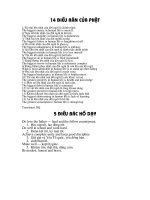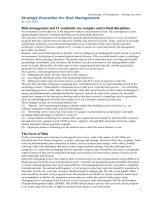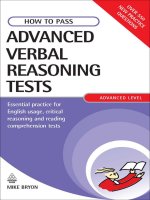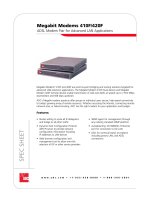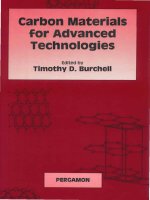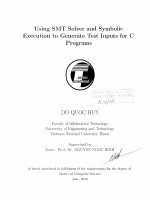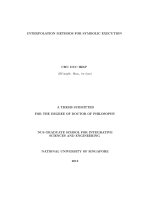Symbolic execution for advanced program reasoning
Bạn đang xem bản rút gọn của tài liệu. Xem và tải ngay bản đầy đủ của tài liệu tại đây (1.64 MB, 168 trang )
SYMBOLIC EXECUTION FOR ADVANCED
PROGRAM REASONING
VIJAYARAGHAVAN MURALI
NATIONAL UNIVERSITY OF SINGAPORE
2014
SYMBOLIC EXECUTION FOR ADVANCED
PROGRAM REASONING
VIJAYARAGHAVAN MURALI
B.Comp. (Hons.), NUS, 2009
A THESIS SUBMITTED
FOR THE DEGREE OF DOCTOR OF
PHILOSOPHY
DEPARTMENT OF COMPUTER SCIENCE
NATIONAL UNIVERSITY OF SINGAPORE
2014
Declaration
I hereby declare that this thesis is my original work and it has been
written by me in its entirety. I have duly acknowledged all the
sources of information which have been used in the thesis.
This thesis has also not been submitted for any degree in any uni-
versity previously.
Vijayaraghavan Murali
Monday 25
th
August, 2014
i
Acknowledgment
First and foremost I would like to thank Professor Joxan Jaffar, who has been
not only my advisor, but also a mentor and role-model. He has supported and
motivated me throughout my Ph.D., during which I learned numerous things
from him about research, teaching, career and life in general. I thank Baba
(God) for bringing this great person into my life.
A special thanks goes to my old teammates Jorge Navas and Andrew Santosa
who showed me that a good researcher needs to first be a good engineer – we
together built the TRACER framework which helped actualise many ideas in this
thesis.
I thank my other collaborators Satish Chandra, Duc-Hiep Chu, Nishant
Sinha and Emina Torlak for showing me the breadth of research in this field
and working together to solve many interesting problems.
I thank Professors Wei-Ngan Chin, Jin-Song Dong, Sanjay Jain, Siau-Cheng
Khoo, Abhik Roychoudhury, Weng-Fai Wong, Roland Yap and many others for
providing valuable insights through teaching. I also thank Professor Razvan
Voicu for directing me to Joxan at the right time in life.
I thank Rasool Maghareh, Gregory Duck, Asankhaya Sharma, Pang Long,
Marcel Böhme, Konstantin Rubinov and other colleagues and friends in the
lab for their lively discussions. I thank my 6-year housemate Thyagu for his
company and being almost a brother to me. I also thank anyone who would
have helped me but I might have forgotten inadvertently.
Last but not least, I cannot find words to express thanks for my Amma
(mother) and Appa (father) who gave all they had, and more, to see their son
titled Ph.D. They are, simply put, my life and to whom I dedicate this thesis
ii
To my parents Meera and Murali, with Baba’s blessings
iii
Contents
1 Introduction 1
1.1 Overview of Current Techniques . . . . . . . . . . . . . . . . . 2
1.2 Overview of Symbolic Execution . . . . . . . . . . . . . . . . . 6
1.3 Thesis Contributions . . . . . . . . . . . . . . . . . . . . . . . 8
2 Preliminaries 12
2.1 Symbolic Execution . . . . . . . . . . . . . . . . . . . . . . . . 12
2.2 Interpolation and Witnesses . . . . . . . . . . . . . . . . . . . . 16
2.3 Implementation: TRACER . . . . . . . . . . . . . . . . . . . . . 22
3 Backward Slicing 25
Part I: Static Backward Slicing 26
3.1 Motivating Example . . . . . . . . . . . . . . . . . . . . . . . 29
3.2 Background . . . . . . . . . . . . . . . . . . . . . . . . . . . . 32
3.3 Algorithm . . . . . . . . . . . . . . . . . . . . . . . . . . . . . 33
3.4 Experimental Evaluation . . . . . . . . . . . . . . . . . . . . . 41
3.5 Related Work . . . . . . . . . . . . . . . . . . . . . . . . . . . 43
3.6 Summary . . . . . . . . . . . . . . . . . . . . . . . . . . . . . 45
Part II: Slice-based Program Transformation 46
3.7 Related Work . . . . . . . . . . . . . . . . . . . . . . . . . . . 48
3.8 Basic Idea . . . . . . . . . . . . . . . . . . . . . . . . . . . . . 51
3.9 Background . . . . . . . . . . . . . . . . . . . . . . . . . . . . 57
3.10 Algorithm . . . . . . . . . . . . . . . . . . . . . . . . . . . . . 57
3.11 Experimental Evaluation . . . . . . . . . . . . . . . . . . . . . 66
iv
3.12 Summary . . . . . . . . . . . . . . . . . . . . . . . . . . . . . 70
4 Concolic Testing 71
4.1 Related Work . . . . . . . . . . . . . . . . . . . . . . . . . . . 73
4.2 Running Example . . . . . . . . . . . . . . . . . . . . . . . . . 75
4.3 Background . . . . . . . . . . . . . . . . . . . . . . . . . . . . 79
4.4 Algorithm . . . . . . . . . . . . . . . . . . . . . . . . . . . . . 80
4.5 Experimental Evaluation . . . . . . . . . . . . . . . . . . . . . 86
4.6 Summary . . . . . . . . . . . . . . . . . . . . . . . . . . . . . 94
5 Interpolation-based Verification 95
5.1 Examples . . . . . . . . . . . . . . . . . . . . . . . . . . . . . 97
5.2 Background . . . . . . . . . . . . . . . . . . . . . . . . . . . . 101
5.3 Algorithm . . . . . . . . . . . . . . . . . . . . . . . . . . . . . 102
5.4 Experimental Evaluation . . . . . . . . . . . . . . . . . . . . . 106
5.5 Related Work and Discussion . . . . . . . . . . . . . . . . . . . 110
5.6 Summary . . . . . . . . . . . . . . . . . . . . . . . . . . . . . 112
6 Trace Understanding 113
6.1 Related Work . . . . . . . . . . . . . . . . . . . . . . . . . . . 123
6.2 Background . . . . . . . . . . . . . . . . . . . . . . . . . . . . 126
6.3 Algorithm . . . . . . . . . . . . . . . . . . . . . . . . . . . . . 127
6.4 Experimental Evaluation . . . . . . . . . . . . . . . . . . . . . 136
6.5 Summary . . . . . . . . . . . . . . . . . . . . . . . . . . . . . 143
7 Conclusion 144
7.1 Future Directions . . . . . . . . . . . . . . . . . . . . . . . . . 146
v
Summary
This thesis aims to address a number of program reasoning problems faced
every day by programmers, using the technique of symbolic execution. Sym-
bolic execution is a method for program reasoning that executes the program
with symbolic inputs rather than actual data. It has the advantage of avoid-
ing “infeasible” paths in the program (i.e., paths that cannot be exercised for
any input), exploring which could provide spurious information about the pro-
gram and mislead the programmer. However, as symbolic execution considers
the feasibility of individual paths, the number of which could be exponential in
general, it suffers from path explosion. To tackle this, we make use of the tech-
nique of interpolation, which was recently developed to alleviate path explosion
by intelligently pruning the exploration of certain paths.
In this thesis, we investigate the following problems, elaborate challenges
that our method faces in solving each problem, and show with evidence how
our method is either better than current state-of-the-art techniques or benefits
them significantly:
• Backward Slicing: the (static) slice of a program with respect to a par-
ticular variable at a program point is, informally, the subset of program
statements that might affect the value of said variable at that point. The
challenge here is to find the right balance between precision of slicing
information and efficiency. Addressing this challenge, we formulate the
most precise slicing algorithm that works with reasonable efficiency. In-
spired by this result, we extend our method to go beyond static slicing,
by introducing the notion of “Tree slicing” that produces a more general
transformation of the program compared to static slicing. We show how
tree slicing can be much more powerful than static slicing in reducing the
program’s search space.
• Concolic Testing: recently, a technique called concolic testing was pro-
posed to automatically generate test cases that maximise coverage. Con-
colic testing also suffers from path explosion as it aims to test every path
vi
in the program, which could be exponential in number. Employing in-
terpolation in this setting fails to provide much benefit, if any, due to the
poor formation of interpolants from test cases the concolic tester executes.
Thus, we introduce a novel algorithm to accelerate the formation of inter-
polants which, for the first time, brings to concolic testing the exponential
benefit that interpolation is known for.
• Interpolation-based Verification: verifying a program is the process of
proving that a program satisfies a given property. Recently, symbolic ex-
ecution has gained traction in verification due to its ability to avoid infea-
sible paths, exploring which may result in spurious “false-positives”. We
conjecture that this aversion of infeasible paths hinders the discovery of
good interpolants, which are vital in pruning the search space in future.
We formulate a new strategy for symbolic execution that temporarily ig-
nores the infeasibility of paths in pursuit of better interpolants. Although
this may seem antithetical to the principle of symbolic execution, our re-
sults show this “lazy” method of symbolic execution that ignores infea-
sibilities is able to outperform the canonical method significantly. This
unprecedented result opens up a new dimension for symbolic execution
and interpolation based reasoning.
• Trace Understanding: understanding execution traces (typically error
traces) has been a nightmare for programmers, mainly due to long loop
iterations in the trace. We propose a new method to aid in the under-
standing of traces by compressing loops using invariants that preserve the
semantics of the original trace with respect to a “target” (e.g., an assertion
violated by an error trace). The novelty of this method is that if we are un-
able to find such an invariant, we dynamically unroll the loop and attempt
the discovery at the next iteration, where we are more likely to succeed as
the loop stabilises towards an invariant.
vii
List of Tables
3.1 Results on Intel 3.2Gz 2Gb.
1
timeout after 2 hours or 2.5 Gb of
memory consumption . . . . . . . . . . . . . . . . . . . . . . . 42
3.2 Statistics about the PSS-CFG . . . . . . . . . . . . . . . . . . . 66
3.3 Experiments on the PSS-CFG for concolic testing . . . . . . . . 68
3.4 Experiments on the PSS-CFG for verification . . . . . . . . . . 69
5.1 Verification Statistics for Eager and Lazy SE (A T/O is 180s (3
mins)) . . . . . . . . . . . . . . . . . . . . . . . . . . . . . . . 108
6.1 Trace statistics for our experiments. %C: percentage compres-
sion, #U: number of unrolls until compression was achieved (in-
ner loop unrolls, if any) . . . . . . . . . . . . . . . . . . . . . . 136
6.2 Trend with varying loop bounds for cdaudio and floppy . . . . . 141
viii
List of Figures
2.1 (a) A program to swap two integers (b) Its transition system . . . 14
2.2 Symbolic Execution Tree of the program in Fig. 2.1 . . . . . . . 15
2.3 (a) A verification problem (b) Its full symbolic execution tree . . 20
2.4 Building the Symbolic Execution Tree with Interpolation (WP) . 21
2.5 Architecture of TRACER . . . . . . . . . . . . . . . . . . . . . 23
3.1 (a) A program and its transition system, (b) its naive sym-
bolic execution tree (SET) for slicing criterion (underlined state-
ments)
9
,{z} . . . . . . . . . . . . . . . . . . . . . . . . . . 29
3.2 Interpolation-based Symbolic Execution Tree for Fig. 3.1 . . . . 30
3.3 Main Abstract Operations for D
ω
. . . . . . . . . . . . . . . . 34
3.4 Path-Sensitive Backward Slicing Analysis . . . . . . . . . . . . 37
3.5 A program and its symbolic execution tree . . . . . . . . . . . . 51
3.6 The PSS-CFG and corresponding transformed program for
Fig. 3.5 . . . . . . . . . . . . . . . . . . . . . . . . . . . . . . 54
3.7 Symbolic execution interleaved with dependency computation
to produce the SE tree . . . . . . . . . . . . . . . . . . . . . . . 59
3.8 Transformation rules to produce the final PSS-CFG . . . . . . . 63
4.1 A program and its symbolic execution tree . . . . . . . . . . . . 76
4.2 A Generic Concolic Tester . . . . . . . . . . . . . . . . . . . . 80
4.3 Symbolic execution with interpolation along a path . . . . . . . 81
4.4 A Generic Concolic Tester with Pruning . . . . . . . . . . . . . 83
4.5 Timing for (a) cdaudio (b) diskperf (c) floppy (d) kbfiltr. X-axis:
Paths, Y-axis: time in seconds . . . . . . . . . . . . . . . . . . 89
ix
4.6 Subsumption for (a) cdaudio (b) diskperf (c) floppy (d) kbfiltr.
X-axis: Paths, Y-axis: % subsumption . . . . . . . . . . . . . . 91
4.7 Extra coverage provided for (a) cdaudio (b) diskperf (c) floppy
(d) kbfiltr by our method. X-axis: Crest path coverage, Y-axis:
Additional path coverage from subsumption. . . . . . . . . . . . 93
5.1 Proving y ≤ n: Eager vs Lazy . . . . . . . . . . . . . . . . . . . 97
5.2 A Program and its (Eager) SE Tree with Learning . . . . . . . . 99
5.3 Lazy SE Tree with Learning . . . . . . . . . . . . . . . . . . . 100
5.4 A Framework for Lazy Symbolic Execution with Speculative
Abstraction . . . . . . . . . . . . . . . . . . . . . . . . . . . . 103
6.1 Hoare triples generated for the program for_bounded_loop1.c 118
6.2 (a) Program with nested loops (b) Its compressed trace . . . . . 120
6.3 Loop Compression with Invariants . . . . . . . . . . . . . . . . 128
6.4 Basic Individually Invariant Discovery . . . . . . . . . . . . . . 131
6.5 Invariant Generalisation using Weakest Precondition . . . . . . 133
6.6 Symbolic Execution trees for the invariants in Fig. 6.2(b) . . . . 134
6.7 The SSH client program, the error trace and the compressed trace 137
6.8 The SSH server program, the error trace and the compressed trace139
x
Chapter 1
Introduction
“The most important property of a program is whether it accomplishes the in-
tentions of its user”, writes C.A.R. Hoare in his seminal article [55] laying the
foundations of formal program reasoning. It is widely accepted that this prop-
erty is the “Holy Grail” of modern computer science.
Today, every programmer endeavours to achieve this goal at every stage of
software production. While developing the software, the programmer tries to
make sure that bugs are not unwittingly introduced into the code, although this
sentence is an utter understatement of the complexity of the problem. Once the
software is developed, the programmer then tries to increase confidence of its
correctness by designing test cases that effectively explore the code. In case a
bug is found, the programmer has to typically reason about a particular “error
trace” that failed to comply with his/her intentions for the software.
On this note, a recent study [4] by Cambridge University showed that “soft-
ware developers spend 50% of their programming time finding and fixing bugs”
and that “the global cost of debugging software has risen to $312 billion annu-
ally”. Despite this, bugs still manifest regularly in software shipped today. For
instance, the infamous “Heartbleed” bug [5], found just weeks before the time
of writing of this thesis, was the result of the lack of a bounds check, which
caused a read overflow and potentially leaked sensitive information to attackers.
More serious bugs have resulted in the loss of huge amounts of money or worse,
human life [3].
Thus, it is of utmost importance to develop techniques to reason about pro-
1
grams and expose these bugs before the software is made available for pub-
lic use. In a broad sense, the whole area of program analysis was developed
over the past few decades for this purpose. A comprehensive survey of the
entire field would appear daunting at this point, as there have been hundreds,
if not thousands, of papers and books contributing techniques such as, to list
a few, software model checking and abstract interpretation [27, 37], program
slicing [104, 72], automated testing and debugging [49, 97, 108] and more.
1.1 Overview of Current Techniques
The goal of this thesis is to contribute in the following areas of program reason-
ing: program slicing, testing, verification and trace understanding. We briefly
survey some traditional and contemporary techniques in each area.
Program Slicing
Slicing, as defined by Weiser [104], is a technique that identifies the parts of
a program that potentially affect the values of specified variables at a specified
program point—the slicing criterion. This is sometimes referred to as back-
ward slicing. Since Weiser’s original definition, many variants of the notion of
slicing have been proposed, with different methods to compute them (see [103]
for a survey). An important distinction is that between static and dynamic slic-
ing [72], where the former does not assume any input provided to the program,
and the latter assumes a particular input. Our focus here is on static backward
slicing, which was originally intended to help programmers in debugging.
Static slicing was initially performed in [104] using data-flow analysis, by
computing consecutive sets of indirectly relevant statements according to data
and control dependencies. A different method that applies reachability analysis
on the Program Dependence Graph (PDG) was proposed in [86, 42]. The prob-
lem of interprocedural slicing was later addressed in [57, 58], which proposed
the idea of using a System Dependence Graph (SDG). The key argument was
that slices computed by previous works were too imprecise due to not being able
to distinguish between a realisable and non-realisable calling context.
2
Parallel to this, the framework of abstract interpretation was developed
by [27], which simulates execution of the program on an abstract domain that
shares a Galois-connection with the concrete domain. Once a fixed point is
reached in the abstract domain, several concrete states can be combined to a
single abstract state and the process terminates. Slicing can be formulated in
abstract interpretation by defining the abstract domain to be the set of all possi-
ble dependency variables at a program point.
Today, slicing is being applied in program testing, differencing, mainte-
nance, debugging, optimisation etc. However, the main problem still being
faced is that slices are bigger than expected and sometimes too big to be useful,
as [10] experimentally found out. One of the most important reasons for im-
precision is the lack of consideration of the feasibility of program paths, many
of which could be infeasible (i.e., not executable for any input), similar to the
claim laid by [57, 58] for calling contexts. Our work aims to address this issue.
Program Testing
Software testing is any activity aimed at evaluating an attribute or capability of
a program or system and determining that it meets its required results [54]. The
process of testing executes a given program with some inputs, and the objective
is to find bugs or validate the program with respect to the given inputs. Indeed,
Dijkstra expressed in his notes [35] that “testing can only prove the presence
of bugs, but not their absence”. Nevertheless, testing is the oldest and still the
most commonly used method to ensure software quality. Traditionally, testing
was carried out manually, by programmers writing test cases themselves based
on their understanding of the code (of course, this practice exists even today).
Automated testing methods such as random testing [102, 48], also called
“fuzzing”, were introduced to generate random inputs with an aim to make the
program crash or observe for memory leaks. This has the advantage of not re-
quiring the source code of the program (referred to as “black-box” testing), and
hence can be readily applied to test large applications such as C compilers [107].
Although random testing has helped in detecting various bugs throughout his-
tory, the randomness of inputs used in fuzzing is often seen as a disadvantage,
3
as catching a boundary value condition with random inputs is highly unlikely.
A primitive fuzzer may also have poor code coverage; for example, if the input
to a program is a file and its checksum, and the fuzzer generates random files
and random checksums, only the checksum validation code in the program will
be tested.
More recently, a technique called Directed Automated Random Testing
(DART) [49, 97] was proposed as an alternative to random testing. DART ex-
ecutes the program with a given input, and obtains a formula describing the
program path that was executed by the input (making this a “white-box” testing
technique). Then, it makes sure to not execute the same path by negating one
of the branches in the path formula, solving the new formula using a theorem
prover, and generating (random) test inputs that satisfy the new formula. This
has been shown to significantly increase the coverage of random testing [16].
An important technical problem with DART, also referred to as “concolic
testing”, or more formally “dynamic symbolic execution”, is that as it aims to
test every path in the program, it can run into path explosion. In this thesis, we
address this issue.
Program Verification
Verification is the process of constructing a mathematical proof that a program
satisfies a given property. Properties come in two types: safety (i.e., those that
state that something “bad” will never happen) and liveness (i.e., those that state
that something “good” will eventually happen). In this work, we are only con-
cerned with safety properties.
The seminal work by Hoare [55] established the foundations of reasoning
by which to prove a program correct. For each building block of the program, a
Hoare triple—an assume-guarantee style proof—is computed, which can then
be composed with other such triples to construct a proof for the program. The
disadvantage of this method is that a significant amount of manual effort is
needed in the form of invariants and user-assertions.
Model checking [37] was proposed as a technique to automatically verify
hardware designs, by typically constructing a finite state machine of the hard-
4
ware model and reducing the problem to graph search. In the case of software
systems, which are typically infinite-state, abstraction has to be employed to
make the model finite. This can result in spurious counter-examples (i.e., false
positives). Recent techniques such as Counter-Example Guided Abstraction Re-
finement (CEGAR) [24, 9] have addressed this by starting with a coarse model
of the program and then refining the model by analysing the spurious counter-
examples, until a “real”
1
counter-example is found.
Recently, the technique of symbolic execution, which we will use in this
work, has gained momentum in program verification [59]. It presents a dual
approach to CEGAR, by starting with the concrete model of the program and
removing irrelevant facts from it that are not needed for the proof. The main
advantage of symbolic execution is that it avoids the expensive computation of
the abstract post operation as in CEGAR.
Trace Understanding
When a program fails, the cause of the failure is often buried in a long, hard-to-
understand error trace. For this reason, techniques to help with understanding
an error trace are valuable in debugging. “Understanding” is a very subjective
term, so we make it concrete: our focus is on the loop iterations that typically
make the trace long, and our goal is to compress them. Since this is a relatively
narrow area of research, prior work in this area is limited.
Traditional methods of trace compression include dynamic slicing [72] on
the variables in the assertion violated by the error trace. Dynamic slicing, how-
ever, only removes statements that it can deem irrelevant through dependency
information (data or control flow). It does not reason about the semantics of the
trace. This weakness was addressed recently in [39], that computed so-called
“error invariants”—abstractions of the state that are still sufficient to violate
the assertion—at each point along the trace. If two points have the same error
invariants, any intervening statement is deemed irrelevant to the error, as the
reason the trace violated the assertion has not changed between the two points.
1
We say “real” (in quotes) because undecidability restricts any software verification method
from being complete; the method can sometimes fail to prove or disprove a property.
5
However, these error invariants are not guaranteed to be loop invariants. Thus,
the practical problem of long loop iterations in error traces still remains directly
unaddressed, which is the motivation for our work in this area.
1.2 Overview of Symbolic Execution
So far, we have just seen the “tip of the iceberg” in the area of program reason-
ing. Even at this level, many static analyses often suffer from the problem of
imprecision, mainly due to the assumption that all program paths are executable.
Many paths, in fact, are not executable (or feasible) for any input because of con-
flicts in the logic of statements along the path. Gathering analysis information
from these paths gives rise to spurious results, which may mislead the program-
mer. The art of analysing programs paying heed to whether individual paths are
feasible or not is commonly referred to as path sensitivity.
It is folklore that path sensitive analyses are much more precise than path in-
sensitive analyses. Hence it is natural to wonder “why are not all analyses path
sensitive?” The reason is that path sensitivity suffers from a major problem: the
number of paths to explore in a program is in general exponential in the number
of branches. Considering the feasibility of each path to derive analysis informa-
tion results in an exponential blowup. This is referred to as the path explosion
problem and it severely limits the scalability of path sensitive analyses.
Due to this, many program analyses are either path insensitive or use some
heuristics to skirt the path explosion issue. For instance, many state-of-the-
art slicers available today (e.g., [25]) are path insensitive, and concolic testers
which are (or rather, must be) path sensitive (e.g., [16]) use metrics such as
branch coverage (as opposed to path coverage) to measure the quality of their
testing procedure. That is, they forfeit the goal of generating tests to exercise
every program path and instead target the much easier goal of generating tests
to just exercise every branch (i.e., basic block) in the program. Thus, there is
much need to perform path sensitive program analyses efficiently.
In this thesis, we employ a technique called symbolic execution to address
6
these problems. Symbolic execution [71], as the name implies, executes a pro-
gram not with actual inputs but with symbolic inputs. The program statements
that are encountered during this execution are collected in a first-order logic
(FOL) formula called the path condition
2
. This formula is the crux of the versa-
tility of symbolic execution, as it can be analysed to derive a host of information.
For instance, it can be checked for satisfiability in order to infer whether the cor-
responding path is feasible (i.e., the path can be exercised by some input), it can
be checked for the existence of bugs (i.e., assertion violations), it can be used to
compute variable dependencies along the path, compute the (abstract) execution
time of the path, and so on. Such information can be collected across multiple
symbolic paths to derive some property about a program point, variable or even
the whole program.
The key advantage of symbolic execution is that it can avoid the exploration
of paths that are not feasible by stopping and backtracking the moment unsatisfi-
ability is detected in the path condition. This offers a natural way to perform pre-
cise path sensitive analysis. However it suffers from the path explosion problem,
as it attempts to consider the feasibility of every single path in the program. To
address this problem, we use the technique of interpolation [28, 81, 66], which
has been recently employed to mitigate state space blowup in model checking,
and the concept of witnesses [66].
Briefly, the high level idea of interpolation and witnesses is as follows
3
.
Whenever symbolic execution explores an entire tree of path arising from a
node, we “learn” some relevant information about the tree— for instance, in the
case of testing, we learn the essence of why the tree is bug-free. This informa-
tion, called the interpolant, can be learned from the path condition of the tree’s
root node, and is typically much more succinct than (formally, an abstraction of)
its path condition. We also compute what is called a witness, a formula which
describes the (sub)-analysis of the tree.
Then, when reaching the same program point through a different path, we
check if the stored interpolant and witness are implied by the new path condi-
2
The variables in constraints arising from the statements are assumed to be implicitly exis-
tentially quantified.
3
Interpolation and witnesses are explained in full detail in the rest of the thesis.
7
tion. If the implication holds, the node can be subsumed (or covered), because
it can be guaranteed to produce the same analysis result if explored. This can
result in exponential savings because the entire tree of paths arising from the
program point is pruned due to subsumption. The key insight is that the sub-
sumed node can reuse the analysis computed previously by the subsuming node.
Interpolation is therefore critical to the scalability of symbolic execution.
If the subsumption test failed (i.e., the entailment does not hold), symbolic
execution will naturally perform node splitting and duplicate all successors of
the node until the next merge point.
1.3 Thesis Contributions
The thesis that is explored in this work is the following: using symbolic exe-
cution with interpolation, we can develop efficient and powerful techniques for
path sensitive analysis for a variety of program reasoning problems.
In Chapter 2, we setup the formal background of symbolic execution and
present our framework TRACER, first demonstrated in [64], on which the ideas in
this thesis are implemented. In Chapter 3, we present our two main contributions
to the area of slicing: first, a method to efficiently perform static path-sensitive
backward slicing, published in [65], and second, a more powerful program trans-
formation technique based on path-sensitive slicing, published in [61]. In Chap-
ter 4, published in [63], we introduce interpolation for the first time to the area of
concolic testing and show its exponential benefits in boosting concolic testing.
In Chapter 5, published in [21], we propose a novel technique of “lazy” sym-
bolic execution that outperforms current techniques significantly in the context
of interpolation-based program verification. In Chapter 6, presented in [62], we
employ symbolic execution to tackle the very practical problem of compressing
long loop iterations in error traces and explain the compressed trace to the pro-
grammer. Finally, Chapter 7 concludes the thesis. The published work [84] is
also a part of our contribution to trace understanding, and is alluded to in the
concluding chapter.
8
Organisation
In each chapter, we present a symbolic execution and interpolation based algo-
rithm to address a particular problem, and show with evidence how our proposed
method is either more powerful than existing techniques or benefits them signif-
icantly. Importantly, we also elaborate the challenges that symbolic execution
and interpolation themselves face in each setting and how to adapt them for
solving each problem. Specifically, the problems addressed in this work are the
following:
• Backward Slicing (Chapter 3)
In Chapter 3, the first part of which was published in [65], we propose a
novel symbolic execution based algorithm to compute static slices. One
ground-breaking result of our method is that it produces exact slices for
loop-free programs. By “exact” we mean that the algorithm guarantees
to not produce dependencies from spurious (i.e., non-executable) paths.
In other words, our algorithm produces the smallest possible slice of a
loop-free program for any given slicing criterion, limited only by gen-
eral theorem proving technology that can deduce the (un)satisfiability of
a (first-order logic) formula
4
.
Inspired by the previous result that slicing is more effective when there
is path sensitivity, we present in the second part of Chapter 3 (published
in [61]) a transformation of programs with specified target variables, sim-
ilar to a slicing criterion. These programs are ready to be analysed by a
third-party application that seeks some information about the target vari-
ables, such as a verifier seeking a property on them. The transforma-
tion embodies a path-sensitive expansion of the program so that infeasible
paths can be excluded, and is sliced with respect to the target variables.
4
Of course, this problem is undecidable in general, and so is the exact slicing problem.
9
Due to path-sensitivity, the slicing is more precise than otherwise. Third-
party applications of testing and verification perform substantially better
on the transformed program compared to a statically sliced one.
• Concolic Testing
5
(Chapter 4)
Recently, to alleviate the problem of manually generating test cases
and poor quality of code coverage from random testing, concolic test-
ing [97, 49, 18, 16]—a portmanteau of “concrete” and ”symbolic”—was
proposed. As mentioned in Section 1.1, concolic testing also suffers from
path explosion, as there are an exponential number of paths to test.
In Chapter 4, published in [63], we propose a novel algorithm to address
path explosion in concolic testing using interpolation. We first show that
the typical modus operandi of interpolation does not work in concolic
testing due to the lack of control of a search order, which in this setting is
imposed by the concolic tester. This greatly hinders the formation of in-
terpolants from running test cases. Then, we propose a new method based
on subsumption to accelerate the formation of interpolants in order to get
back the exponential benefits that it is known for. Finally, we show with
evidence that our proposed algorithm boosts the coverage of an existing
concolic tester significantly.
• Interpolation-based Verification (Chapter 5)
In Chapters 3 and 4, we show how powerful symbolic execution with
interpolation is in program analysis (slicing) and testing. In both set-
tings, its effectiveness heavily relies on the quality of the computed in-
terpolants, which are the key to mitigating path explosion. Symbolic exe-
cution avoids the exploration of infeasible paths by stopping the moment
infeasibility is encountered in its path condition, a property referred to as
being eager, and one considered an advantage.
5
Concolic testing is now commonly referred to as “dynamic symbolic execution”. We use
the former term for historical reasons.
10
In Chapter 5, published in [21], we show that in the setting of program
verification, being eager is not always beneficial for symbolic execution,
as it can hinder the discovery of better interpolants. We present a sys-
tematic algorithm that speculates that an infeasibility may be temporarily
ignored for the purpose of “learning” better interpolants about the path in
question. This speculation is bounded and so does not make symbolic ex-
ecution lose its intrinsic benefits. We demonstrate using real benchmarks
that this “lazy” variant of symbolic execution that ignores infeasibilities
outperforms its eager counterpart by a factor of two or more.
• Trace Understanding (Chapter 6)
Reasoning about long execution (typically, error) traces is an integral but
tedious part of software development, especially in debugging. In Chap-
ter 6, presented in [62], we propose an algorithm to compress execution
traces by discovering loop invariants for the iterations in the trace. The
invariants discovered are “safe”, such that the compressed trace obeys the
original trace’s semantics regarding the assertion at the end. Thus, the
compressed trace concisely explains the original trace without unrolling
the loops fully.
A central feature is the use of a canonical loop invariant discovery al-
gorithm which preserves all atomic formulas in the representation of a
symbolic state which can be shown to be invariant. If this fails to pro-
vide a “safe” invariant, then the algorithm dynamically unrolls the loop
and attempts the discovery at the next iteration, where it is more likely to
succeed as the loop stabilises towards an invariant. We show via realistic
benchmarks, which present the compressed trace as a Hoare proof, that
the end result is significantly more succinct than the original trace.
11
Chapter 2
Preliminaries
Throughout this thesis, we restrict our presentation to a simple imperative pro-
gramming language where all basic operations are either assignments or assume
operations, and the domain of all variables are integers (pointers are treated as
indices on a special array representing the heap). The set of all program vari-
ables is denoted by Vars. An assignment x = e corresponds to the assignment
of the evaluation of the expression e to the variable x. In the assume opera-
tor, assume(c), if the Boolean expression c evaluates to true, then the program
continues, otherwise it halts. The set of operations is denoted by Ops. We
then model a program by a transition system. A transition system is a quadru-
ple Σ,I,−→,O where Σ is the set of states and I ⊆ Σ is the set of initial
states. −→⊆ Σ ×Σ ×Ops is the transition relation that relates a state to its
(possible) successors. This transition relation models the operations that are
executed when control flows from one program location to another. We shall
use
op
−−→
to denote a transition relation from ∈ Σ to
∈ Σ executing the
operation op ∈ Ops. Finally, O ⊆ Σ is the set of final states.
2.1 Symbolic Execution
A symbolic state υ is a triple ,s,Π. The symbol ∈ Σ corresponds to the
current program location. For clarity of presentation in our algorithm, we will
use special symbols for initial location,
start
∈ I, final location,
end
∈ O, and
bug location
error
∈ O (if any). W.l.o.g we assume that there is only one initial,
12
final, and bug location in the transition system. We shall use a similar notation
υ
op
−−→ υ
to denote a transition from the symbolic state υ to υ
corresponding
to their program locations.
The symbolic store s is a function from program variables to terms over
input symbolic variables. Each program variable is initialised to a fresh in-
put symbolic variable. This is done by the procedure init_store(). The eval-
uation c
s
of a constraint expression c in a store s is defined recursively as
usual: v
s
= s(v) (if c ≡ v is a variable), n
s
= n (if c ≡ n is an integer),
e op
r
e
s
= e
s
op
r
e
s
(if c ≡ e op
r
e
where e,e
are expressions and op
r
is a relational operator <,>,=,! =,>=,<=), and e op
a
e
s
= e
s
op
a
e
s
(if c ≡ e op
a
e
where e,e
are expressions and op
a
is an arithmetic operator
+,−,×, ). Sometimes, when the context of usage is clear, we simply say υ
to mean the evaluation of the symbolic state υ with its own symbolic store.
Finally, Π is called path condition, a first-order formula over the symbolic
inputs that accumulates constraints which the inputs must satisfy in order for
an execution to follow the particular corresponding path. The set of first-order
formulas and symbolic states are denoted by FOL and SymStates, respectively.
Given a transition system Σ,I,−→,Oand a state υ ≡,s,Π∈SymStates, the
symbolic execution of
op
−−→
returns another symbolic state υ
defined as:
SYMSTEP(υ,
op
−−→
)
υ
,s,Π ∧c
s
if op ≡ assume(c) and
Π ∧c
s
is satisfiable
,s[x → e
s
],Π if op ≡ x = e
(2.1)
Note that Equation (2.1) queries a constraint solver for satisfiability checking on
the path condition. We assume the solver is sound but not necessarily complete.
That is, the solver must say a formula is unsatisfiable only if it is indeed so.
Abusing notation, given a symbolic state υ ≡ ,s,Π we define υ :
SymStates → FOL as the formula (
v ∈ Vars
v
s
) ∧Π where Vars is the set
of program variables.
A symbolic path π ≡υ
0
·υ
1
· ·υ
n
is a sequence of symbolic states such that
13
